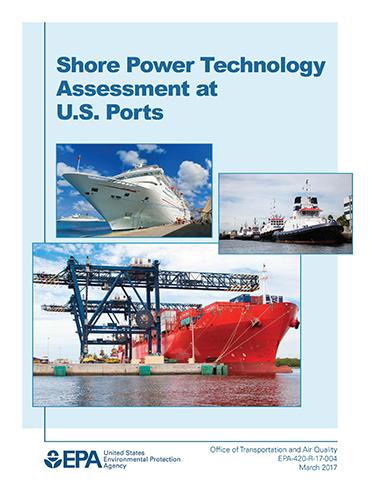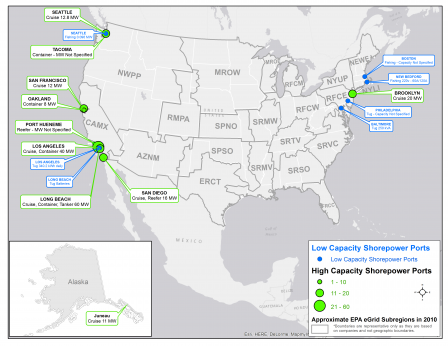Shore Power Technology Assessment at U.S. Ports
 On this page
On this pageOverview
Ports are major centers for movement of goods and passengers from vessels in the United States and are vital to America’s business competitiveness, jobs, and economic prosperity. Goods and passengers moving through ports are projected to grow as are size of ships due to the opening of the new Panama Canal locks in 2016 and other factors. Some vessel types, such as cruise, container, and refrigeration, can require significant power while at berth. This power is typically generated by diesel auxiliary engines.
Emissions from vessels running auxiliary diesel engines at berth can be significant contributors to air pollution. Exposure to air pollution associated with emissions from ocean going vessels and other diesel engines at ports (including particulate matter, nitrogen oxides, ozone, and air toxics) can contribute to significant health problems—including premature mortality, increased hospital admissions for heart and lung disease, increased cancer risk, and increased respiratory symptoms – especially for children, the elderly, outdoor workers, and other sensitive populations. Many ports and port-related corridors are also located in areas with a high percentage of low income and minority populations who are often disproportionately impacted by higher levels of diesel emissions.
Shore power can be used by marine vessels to plug into the local electricity grid and turn off auxiliary engines while at-dock. When using shore power, auxiliary systems, such as lighting, air conditioning, and crew berths use energy from the local electrical grid. Shore power typically produces zero onsite emissions. The power generation plant that supplies electricity to shore power applications may or may not be within the confines of the port and can be located outside the local air shed. While shore power can reduce auxiliary engine emissions at berth, shore power does not address emissions from boilers or other vessel sources. The assessment also describes other alternatives that may capture emissions at berth.
 Shore Power Locations at U.S. Ports
Shore Power Locations at U.S. Ports
Click to enlargeThis Shore Power Technology Assessment at U.S. Ports reviews the availability of shore power at ports throughout the U.S., and characterizes the technical and operational aspects of shore power systems installed at U.S. ports. Technical information was gathered working in partnership with ports that have installed shore power. The second part of the assessment presents a new methodology for estimating emission reductions from shore power systems for vessels docked and connected to shore power.
Assessment and Calculator
- Shore Power Technology Assessment (PDF)(57 pp, 3 MB, March 2017, EPA-420-R-17-004, About PDF)
- Use the calculator and supporting materials
- Shore Power Emissions Calculator (XLS) (8 pp, 3 MB, March 2017) Free Viewers
- Assessment section on: How to Use the Calculator (PDF) (57 pp, 3 MB, March 2017, EPA-420-R-17-004, About PDF)
If you have questions about Shore Power Assessment, please email: Arman Tanman (tanman.arman@epa.gov)
You may need a PDF reader to view some of the files on this page. See EPA’s About PDF page to learn more.
Key Findings
Shore power can significantly reduce diesel emissions from ships at dock.
- The potential emission reduction benefits may be estimated for a particular vessel, at berth when connected to shore power. Factors such as the amount of time actually connected, power consumption rate, energy costs and total time at berth are described in the assessment and relate to the overall effectiveness of shore power. Because these factors must be evaluated for each situation, total emission reductions may vary.
- The assessment suggests that shore power may be most effective when applied at terminals and ports with a high percentage of frequently returning vessels, typically cruise ships and container ships.
Shore power for commercial marine vessels in the United States is relatively new and at present, not commonly available.
There are currently ten ports using high voltage systems, serving cruise, container and refrigerated (“reefer”) vessels, and 6 ports using low voltage systems, serving tugs and fishing vessels. Though the technology is relatively new in the commercial sector, shore power has been successfully used by the U.S. Navy for decades, and is included in the Navy’s Incentivized Shipboard Energy Conservation program.
Vessels that frequently call on the same ports and remain at berth for longer times are potentially the best applications for shore power.
Many ports do not have the appropriate infrastructure to connect to vessels with shore power components.
Ships can be retrofitted with vessel-side infrastructure to connect to port shore power systems. International shore power standards are in place to make it easier for ports to select the proper equipment.
Barriers to shore power installation include infrastructure and electricity costs.
Shore power requires landside infrastructure, electrical grid improvements, and vessel modifications. The relative cost of using shore power instead of a vessel’s own fuel sources is more attractive when fuel costs are greater than electricity costs.
The Shore Power Emissions Calculator (SPEC) developed in conjunction with this report can be effective for estimating environmental benefits of shore power when a vessel is connected.
- SPEC will be helpful for states and port authorities in evaluating potential benefits and in determining whether shore power would be an appropriate means to reduce pollution at a port.
- SPEC quantifies the changes in emissions when switching off engines of vessels and using shore power systems. The tool uses vessel and activity inputs, as well as the offsetting emissions of electrical power use from shore-side power to determine emission changes for most pollutants. To analyze the shore-side power, the tool uses emission values from EPA’s Emissions & Generation Resource Integrated Database (eGRID). The eGRID contains the environmental characteristics of electrical power generation for almost all regions in the United States.
- While the SPEC is intended to provide consistency in estimating shore power benefits primarily for DERA purposes, the SPEC is not appropriate for certain analyses like those performed in support of State Implementation Plans (SIPs) and Conformity.
- SPEC offers users two ways to estimate emissions. The first is a “General Model", for users with limited project information to estimate emissions reduction benefits through the use of a set of default data and assumptions. The General Model may be updated with more recent information, as available and appropriate. Secondly, a “User Input Model” is provided, which can generate more accurate estimates through user-defined inputs for the vessel auxiliary power, load factor, engine emission factors, and through the selection of specific electric generation facilities and their grid emissions mix, if that information is available to users.
